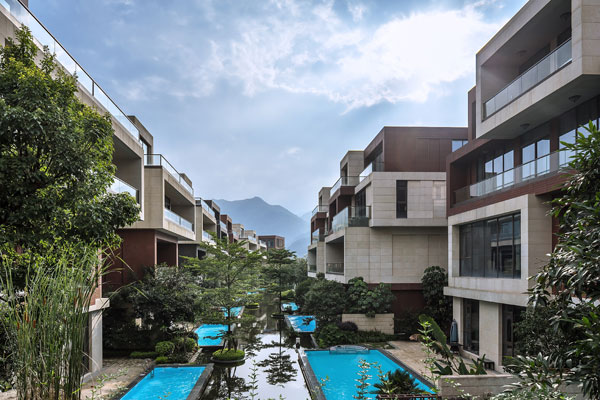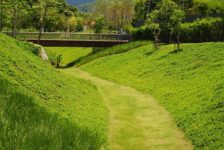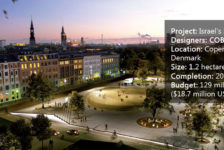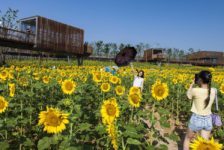Article by Yang Su Lianjiang Butterfly Bay, by NEXT Architects, in Lianjiang, Fuzhou, Fujian Province, China China’s rapid urbanization has meant that high-rise buildings with unique Chinese character have been sprouting up in large numbers in the country’s cities. There has also been an uptick in constructed green space to make up for the deterioration of the natural environment. In this way, China is becoming a leader in environmental design. The traditional value of Chinese aesthetics places an emphasis on “integrated sense” — the integration of heaven and human being, or “harmony is the beauty”. Lianjiang Butterfly Bay, designed by NEXT Architects, is a high-density residential development sitting on the banks of a tributary of the Min River, in the northern part of Fuzhou in Fujian Province. The project’s design philosophy is based on reflecting the Chinese perception of the relationship between man and nature and man’s need to learn from nature.

Lianjiang Butterfly Bay. Image courtesy of NEXT Architects
Lianjiang Butterfly Bay
Blending into Natural Surroundings The 360-degree view of the mountains in the background is purely natural and picturesque. “There is the proximity of the river. We had the ambition to exploit this beauty, to maximize conditions for inhabitants to experience the surrounding nature,” said NEXT Architects partner John Van de Water. “The altering color combinations make the architecture blend into its natural surroundings.”

Lianjiang Butterfly Bay. Image courtesy of NEXT Architects
”
Van de Water said. The residences are set in rows among the finger-like areas of land, which expand toward the river and the mountains. Gardens and swimming pools occupy narrow gaps between each of the fingers. This allows the residents to feel like they are living in two worlds: still in the city, but with an opportunity to relax in the green spaces and work in the out-of-doors. This is reminiscent of the project LAN’s
Elisa Ahmed Mohamed Varetti wrote about in “
Is The Haven Lakeside Residences The Best of Both Worlds?”

Lianjiang Butterfly Bay. Image courtesy of NEXT Architects
Butterfly Bay is not the only Chinese landscape architecture project to benefit from proximity to water. China is gradually improving living environments through proximity to water, as in LAN writer
Erin Tharp’s in-depth article,
The Amazing Zhangjiagang Town River Reconstruction. This Chinese landscape architecture aesthetic encourages social relationships through the creation of vibrant and welcoming gardens and pools. These projects provide a friendly destination for both visitors and residents to relax and get rid of work pressure while bringing people together in the busy city. Like
Erin Tharp said, “
Urban developments should be viewed as communities rather than just a group of buildings.” (
5 Residential Designs That Changed the Way People Live)

Lianjiang Butterfly Bay. Image courtesy of NEXT Architects

Lianjiang Butterfly Bay. Image courtesy of NEXT Architects
The buildings’ varying volumes also create diversity in the outside spaces, and each has its own particular architectural language. “
We sought to create maximum exterior spaces, blurring inside and outside, while at the same time exploiting views over the surroundings from the interiors,”
Van de Water said. The villas themselves are designed to enhance the diverse views over the water and the mountains in the background. The three-story villas face the street and the four-story villas look toward the water. In addition, the underground parking makes the streets between the villas pedestrian friendly and preserves green space.

Lianjiang Butterfly Bay. Image courtesy of NEXT Architects
The emptiness of city life can be re-energized through an emotional experience with a region’s cultural background. Shapes, native plants, and local natural materials advocate the revival of Fujian culture. Some lianas, laurel-leafed plants, rhododendrons, and conifers have been planted. Also, the rich plant variety attracts many birds.

Lianjiang Butterfly Bay. Image courtesy of NEXT Architects
Moreover, the housing units are comprised of three or four stories, each of which embraces a pile of irregular blocks covered in light gray granite and friendly terracotta. The paving is also made of red brick in correspondence with the terracotta. The pavement in the gardens and patios is ornamented with ripple-like circles of red and gray brick, which connects to the walkable, tree-lined avenues that link to the river.

Lianjiang Butterfly Bay. Image courtesy of NEXT Architects
It is no surprise that China is now developing quickly in terms of landscape architecture. You can read about it in LAN writer
Dalia Zein’s captivating article,
5 Countries Where Landscape Architecture is Booming. In addition, China has succeeded in environmental design, as with a project in Yichuan by BLVD International. You can learn how China is changing its relationship with water in
Michelle Biggs’ helpful article
Is China Transforming its Relationship with Water? A Look at the Aiyi River Landscape Park, or her article on another fascinating project in Jiangsu province,
Lotus Lake Park Sets Precedent for Sustainable Urban Design in China.
The Lianjiang Butterfly Bay project integrates mankind and nature in an inspired and welcoming way, making it one example of how China is constantly enhancing living situations in a green and friendly way, creating a social and green environment to welcome humans and animals while protecting natural resources and local culture.
How does this project inspire you? Please let us know in the comments below! Go to comments 
Lianjiang Butterfly Bay. Image courtesy of NEXT Architects
Full Project Credits For Lianjiang Butterfly Bay:
Project Name: Lianjiang Butterfly Bay Type / Program / Purpose: 70 Villa’s, Townhouses (85 units), Two apartment towers (180 units), Boutique hotel, (88 rooms), Commerce, Underground parking Location: Lianjiang, Fujian Province, China Floor area: 120,000 sqm Completion: 2015 Client: Citychamp Real Estate Architect / designer: NEXT architects Contact person: John van de Water Team: John van de Water, Jiang Xiaofei with Wopke Tjipke Schaafstal ,Wang Bo, Wang Yan, Zhou Tong, Yu Peng, Yin Ya Ling, Wen Qing, Wang Fei, Jiang Ci Ai, Liu Feng Qin, Ren Wan Ting Recommended Reading:
Article by Yang Su
Published in Blog



















